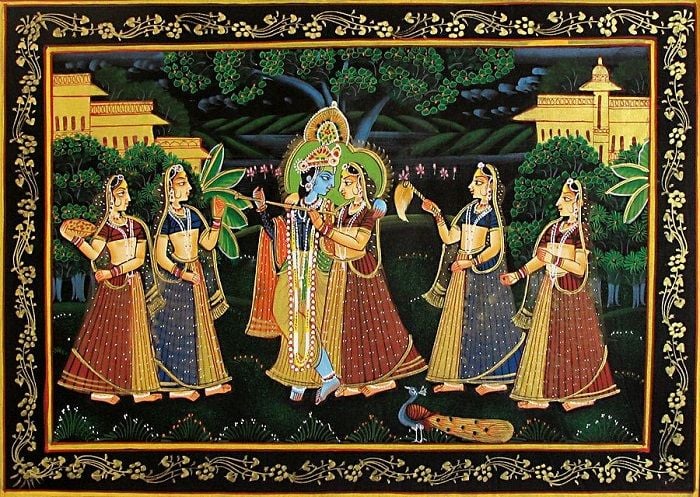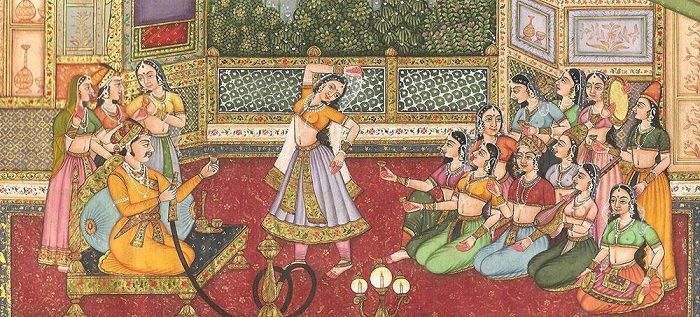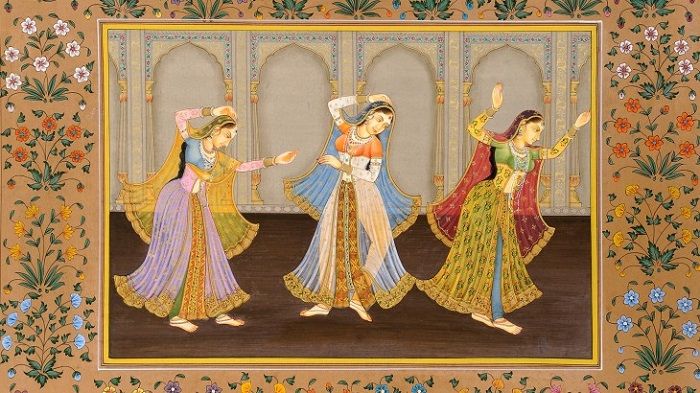Miniature Painting
Miniature Painting
Miniature Painting
As the name suggests, miniature paintings are colorful handmade paintings very small in size. One of the outstanding features of these paintings is the intricate brushwork which contributes to their unique identity. The colors used in the paintings are derived from various natural sources like vegetables, indigo, precious stones, gold and silver. While artists all around the world convey their respective theme through their paintings, the most common theme used in the miniature paintings of India comprises of the Ragas or a pattern of musical notes, and religious and mythological stories. Miniature paintings are made on a very small scale especially for books or albums. These are executed on materials, such as paper and cloth. The Palas of Bengal are considered the pioneers of miniature painting in India, but the art form reached its zenith during the Mughal rule. The tradition of miniature paintings was further taken forward by the artists of various Rajasthani schools of painting, including the Kishangarh, Bundi Jaipur, Mewar and Marwar.

History of Miniature Paintings
Miniature paintings originated in India around 750 A.D when the Palas ruled over the eastern part of India. Since religious teachings of the Buddha, accompanied by his images, were written on palm leaves, these paintings became popular. As these paintings were done on palm leaves, they had to be miniature in nature because of space constraint. Around 960 A.D, similar paintings were introduced in the western parts of India by the rulers of the Chalukya Dynasty. During this period, miniature paintings often portrayed religious themes. With the rise of the Mughal Empire, miniature paintings started growing on a level unknown before. Thanks to Akbar’s love for art, Indian miniature paintings combined elements of Persian style of painting, to give rise to the Mughal style of painting. These miniature paintings further evolved with the influence of European paintings in the Mughal court. Even after the decline of the Mughal Empire, miniature paintings and artists were patronized by the Rajput rulers of Rajasthan. Though influenced by the Mughal style of painting, the miniature paintings of Rajasthan had their own distinct features and often depicted the royal lifestyle and mythological stories of Lord Krishna and Radha. Most of these miniature paintings depicted the lifestyle of kings and queens and also narrated their tales of bravery. Some of these paintings were also created to showcase the contribution of various rulers towards their respective subjects and kingdoms.
Schools of Miniature Paintings
Beginning from the Pala style of miniature paintings, several schools of miniature paintings evolved in India over the course of several centuries. These schools were the products of the social, religious, economic and political atmosphere prevalent in different regions of India. Though these schools of miniature paintings were influenced by each other, they had their own distinct features as well. Some of the important schools of miniature paintings are mentioned below:
Pala School
The earliest Indian miniature paintings are related to the Pala School dating back to the 8th century A.D. This school of painting emphasized on the symbolic use of colors and the themes were often taken from the Buddhist tantric rituals. Images of Buddha and other deities were portrayed on palm leaves and were often displayed in Buddhist monasteries, such as Nalanda, Somapura Mahavihara, Odantapuri and Vikramasila. These miniature paintings attracted thousands of students from far and wide. Thus, the art form spread across South-East Asia and soon, the Pala style of paintings became popular in places like Sri Lanka, Nepal, Burma, Tibet, etc. Apart from the emphasis on symbolic usage of colors, other prominent characteristics of the Pala School include the skillful and graceful usage of lines, and modeling forms by delicate and expressive variation of pressure, usage of natural colors, etc.

Orissa School
The Orissa School of miniature painting came into existence during the 17th century A.D. Though the usage of paper was widespread in India during the 17th century, Orissa School of miniature paintings stuck to its tradition as it continued using palm leaves to display this intricate art form. Most of the paintings depicted the love stories of Radha and Krishna and also stories from ‘Krishna Leela’ and ‘Gita Govinda’. These paintings were rich in color and often depicted the majestic landscape of the eastern parts of India. The strokes used were bold and often expressive.
Jain School
One of the earliest schools of miniature paintings in India, the Jain School of painting gained prominence in the 11th century A.D when religious texts like ‘Kalpa Sutra’ and ‘Kalkacharya Katha’ were portrayed in the form of miniature paintings. Like other schools of miniature paintings, Jain School too, displayed its art works on palm leaves, but started using paper from the late 12th century. Natural colors including gold and silver were used to depict the stories. Some of the exclusive features of these paintings include portrayal of enlarged eyes, square shaped hands and portrayal of stylish figures. Also, the colors used were often vibrant and most often than not, colors like green, red, gold and blue were used. The paintings often displayed male figures and goddesses of the Tirthankara. Also, the goddesses shown in the paintings were often heavily ornamented. These paintings began to decline during the late 16th century.

Mughal School
The amalgamation of Indian paintings and Persian miniature paintings gave rise to the Mughal School of miniature painting. Interestingly, Persian miniature paintings were largely influenced by Chinese paintings. The Mughal style of painting flourished from 16th to 18th centuries, especially under the reign of Akbar. Scenes from the royal court, hunting expeditions, wild life and battles were often displayed through these paintings. Plants and trees were portrayed realistically and the paintings had rich frames that were decorated heavily. Such was the importance given to miniature painting by the Mughal Emperors that many famous artists were commissioned to come up with several pieces of art. The Mughal style of painting also inspired Hindu painters who came up with miniatures depicting stories from ‘Ramayana’ and ‘Mahabharata’. Since the Mughal rule saw various emperors, the style of miniature paintings differed with emperors. While Humayun and Jahangir encouraged paintings that portrayed events from their respective life, in Shah Jahan’s reign painters began giving importance to portraiture. Some of the well-known miniature artists of Shah Jahan's rule were Bichiter, Anup Chattar, Chaitaraman, Inayat, Mohammed Nadir of Samarquand and Makr. In addition to portaiture, many paintings of the period depict groups of ascetics and mystics and several illustrated manuscripts. Mughal miniature paintings started to decline with the reign of Aurangzeb as he is said to have condemned the practice of art, especially miniature paintings.
Rajasthani School
The decline of the Mughal miniature paintings resulted in the rise of the Rajasthani School. Rajasthani School of painting can be further divided into various schools depending on the region they were created in. The Mewar School, Marwar School, Hadoti School, Dhundar School, Kangra and Kullu Schools of art are all part of Rajasthani School of painting. Like the Mughal Emperors, the Rajput rulers were also lovers of art and gave their patronage to miniature paintings.
Each Rajputana kingdom had its own distinct style with a few common features. Apart from depicting stories from the Ramayana and the royal lifestyle of kings and queens, Rajasthani miniature paintings often portrayed the legacy of present and past rulers. They also portrayed social values and the changes introduced by kings for the betterment of society. The background of the paintings formed a special feature of the Rajasthani school. Colors used were often bold and contrasting in nature. Natural colors, extracted from plants, minerals, shells, gold, silver and precious stones, were used. The preparation of colors itself would often take weeks and only fine brushes were used. The difficult art of miniature painting still exists in Rajasthan where the painters often use paper, ivory and silk as their canvas. However, natural colors are no longer used as they have been replaced by artificial colors.

Pahari School
Pahari School of miniature painting emerged in the 17th century A.D. These paintings originated in the kingdoms of North India, in the Himalayan region. Influenced by the Mughal School and the Rajasthani School of miniature paintings, the Pahari style of paintings flourished in the Jammu and Garhwal regions from 17th to 19th centuries. The Pahari School of paintings gave rise to various other schools. Some of the most important schools of paintings under Pahari paintings are Guler School, Basohli School, Garhwal School, Chamba School and Kangra School. Each and every style of painting has its distinct features, but the portrayal of gods and goddesses is one of the most common features of the Pahari School of miniature painting. The scenic beauty of the Himalayas was also often depicted in these paintings. While usage of bold and contrasting colors shows the influence of Rajasthani School of miniature paintings, heavily decorated frames and borders exhibits the influence of the Mughal School.

Deccan School
The Deccan School of miniature painting flourished in places like Ahmednagar, Golconda, Tanjore, Hyderabad and Bijapur from 16th to 19th century A.D. The Deccan School of miniature painting was largely influenced by the rich traditions of the Deccan and the religious beliefs of Turkey, Persia and Iran. These paintings are different from that of their Mughal counterpart. They often portrayed intense colors and sensuous looking female figures. The ladies were portrayed with beautiful faces, large eyes and broad foreheads. Also, symmetrical arrangement played a prominent role in the Deccan School of miniature painting. Even the miniatures that depict scenic beauty have a sense of symmetry attached to it. Instead of frequently portraying trees and plants, the artists from the Deccan School of painting chose to portray geometrically accurate buildings and other man made wonders. These paintings also display the usage of various strokes and depth, creating multi-dimensional effect. Bright colors like red and orange are some of the most important aspects of Deccan School of miniature painting.
Comments
Post a Comment